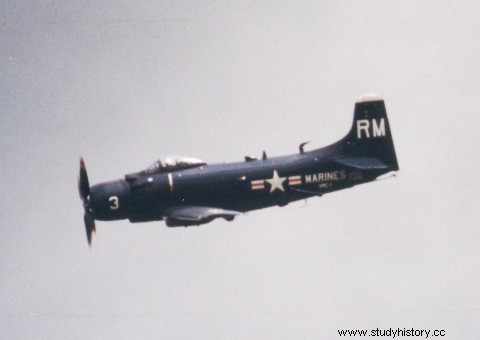
Worse, the new types of aircraft used in Korea proved to be unsuited to this war, and to their main mission:tactical ground support. This new generation of aircraft included some very interesting machines:the U.S. F-80 Shooting Star, F-84 Thunderjet and F-86 Saber. Air Force; the F9F Panther and F2H Banshee of the U.S. The Navy and Marine Corps were incomparably superior to the old planes of the last war reappearing in North Korea.
Again, the B-29s were tasked with strategic bombing missions. The North Koreans had nothing like it to carry out such missions. The B-29s had enough autonomy to intervene from Japan and Okinawa.
But all of these modern aircraft were designed to operate from aircraft carriers or concrete runways, at least 2000m long. Aircraft carriers could cruise off enemy coasts, although security prohibited approaching them closer than 100 km because of shoals; this represented an extreme limit for aircraft damaged in battle. On land, there were hardly any suitable tracks for the new devices.
The best land was around Seoul, already in North Korean hands. In addition, the latest fighters did not adapt well to close support missions. They could theoretically carry 150 mm Tiny Tim rockets or 450 kg bombs; but the too short runways forced them to take off with a very reduced payload.
In the first months of the war, most of the work of combat support was left, on the Allied side, to the piston-engined fighters F-51 Mustang, F4U Corsair and AD Skyraider. They could intervene from summarily developed land and transport significant offensive loads over great distances. But they were more vulnerable, especially at the hands of pilots exhausted from incessant flying.
The Skyraider, with its formidable payload capacity (fifteen attachment points under the wings) and an endurance of ten hours, established itself as the best close support aircraft. The pilots were so exhausted that they had to be dragged out of their cockpits after landing!
Many American tactical squadrons of F-80 Shooting Star were reconverted on the old Mustang P-51. It was the most used aircraft. Its six heavy machine guns and the rockets or bombs it carried allowed it effective attack missions. The weapon best suited to attacking troops and unarmored vehicles was the napalm bomb, a mixture of naphtha and palm oil that exploded producing a huge flame 15m wide by 60m long. The 150 mm air-to-ground rocket destroyed bridges, shields and fortifications. The terrible 400mm Tiny Tim was devoted to the toughest lenses.
